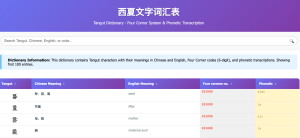Xixia 西夏, better known as the Tangut Empire (1038‒1227), was situated along the eastern segment of the Silk Road. Its dominant religion was Buddhism, and the religious elite produced a remarkably rich body of literature despite the empire’s relatively short existence. The Tangut language belongs to the Tibeto-Burman branch of the Sino-Tibetan language family, however, its writing system was developed based on the structure of Chinese characters.
Due to various fortunate circumstances, a significant portion of this literature—mainly translations from Chinese and Tibetan into the Tangut language—has been preserved. In Buddhist Studies, this exceptional heritage has long received only limited attention, primarily due to the difficulty of integrating these texts into the broader framework of Buddhist history. Traditionally, scholars of Indology and Tibetology often lack proficiency in the Tangut language and the experts in Tangut Studies and Sino-Tibetan Buddhism may not possess the requisite knowledge of Indo-Tibetan Buddhism, such as the ability to deal with Sanskrit manuscripts.
The Tangut script is among the most intricate in the world, composed of over 6,000 logographic characters. Created under imperial decree by Emperor Jingzong, it was intended to serve the official and cultural needs of the Western Xia Empire. Following the Mongol conquest in the 13th century, the language disappeared from daily use, and its script remained undeciphered for centuries. Thanks to the work of modern scholars and the discovery of bilingual materials—most notably the Pearl in the Palm glossary—Tangut can now be studied and appreciated once more. For the input of Tangut character see an online Chinese-Tangut dictionary: http://ccamc.co/fonts_tangut.php.
This online dictionary (Concise Online English–Tangut Dictionary) presents Tangut characters alongside their Chinese and English meanings, phonetic transcriptions, and Four Corner codes. The search feature allows users to look up entries by Tangut character, English or Chinese meaning, or phonetic form. The results are displayed in a clean, visually appealing table with sortable columns, making it easy to explore linguistic patterns or specific vocabulary.

(A preview of the dictionary, the database is still in process)
Bibliography:
Li, Fanwen. A Concise Tangut–Chinese Dictionary. Beijing: Chinese Academy of Social Sciences Press, 2012.
———. Tangut–Chinese Dictionary. Beijing: Chinese Academy of Social Sciences Press, 1997.
Kychanov, E.I. Е.И. Кычанов and S. Arakawa С. Аракава, eds. Tangut Dictionary. Tangut-Russian-English-Chinese Dictionary. Словарь Тангутского (Си Ся) Языка. Тангутско-русско-англо-китайский словарь. Kyoto, Japan: Faculty of Letters, Kyoto University, 2006.
Nishida Tatsuo 西田龍雄. A Study of the Hsi-Hsia Language. Reconstruction of the Hsi-Hsia Language and Decipherment of the Hsi-Hsia Script. 西夏語の研究. 西夏語の再構成と西夏文字の解讀. Vol. 1. Tokyo, Japan: Zauho Kankokai 座右宝刊行会, 1964.
— A Study of the Hsi-Hsia Language. Reconstruction of the Hsi-Hsia Language and Decipherment of the Hsi-Hsia Script. 西夏語の研究. 西夏語の再構成と西夏文字の解讀. Vol. 2. Tokyo, Japan: Zauho Kankokai 座右宝刊行会, 1966.